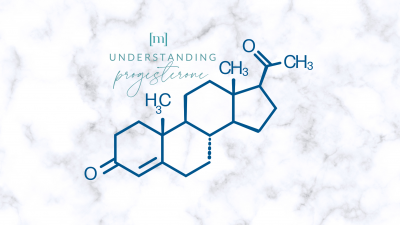Hormones are like the body’s internal GPS — guiding everything from your mood and metabolism to sleep, fertility, and even how well you handle stress. But when hormone levels shift out of balance, the symptoms can be frustrating, confusing, and sometimes even scary.
And while estrogen and testosterone often steal the spotlight in hormone health conversations, there’s one hormone that quietly holds everything together — progesterone.
Whether you're a woman navigating perimenopause or menopause, or someone feeling “off” without knowing why, understanding progesterone may be the missing piece in your hormone puzzle.
What Is Progesterone, Really?
Progesterone is a natural steroid hormone produced in the uterus and then in the ovaries after ovulation. It also comes from the adrenal glands and, during pregnancy, the placenta. For women, progesterone works in tandem with estrogen to regulate the menstrual cycle, support fertility, and maintain a healthy pregnancy.
But its benefits go far beyond reproduction.
Progesterone is often referred to as the “calming hormone” because of its effects on the brain, sleep, and nervous system. It plays a critical role in:
- Mood regulation and anxiety control
- Deep, restorative sleep
- Bone health and joint flexibility
- Libido and sexual function
- Cognitive clarity and memory
- Protecting against estrogen dominance
And yes — men need progesterone too, just in smaller amounts. It helps balance testosterone and supports brain health, mood, and even prostate function.
How Progesterone Changes Over Time
For Women:
- In your 30s and 40s, progesterone often drops before estrogen does, leading to symptoms like PMS, breast tenderness, irritability, mood swings and heavy periods.
- During perimenopause, ovulation becomes less consistent — and since ovulation triggers progesterone production, levels continue to decline.
- By menopause, progesterone levels are often very low or nonexistent.
For Men:
- While men produce far less progesterone, levels may still decline with age, especially as testosterone decreases and estrogen rises.
The Symptoms of Low Progesterone
If you’re feeling “off” and haven’t been able to put your finger on why, low progesterone could be the culprit. Here’s what to watch for:
Common Signs in Women:
- Trouble falling or staying asleep
- Increased anxiety or feeling on edge
- Shorter cycles or irregular periods
- Heavy bleeding or intense cramps
- Breast tenderness
- Brain fog or poor memory
- Low libido
- Weight gain, especially around the midsection
Common Signs in Men:
- Mood swings or irritability
- Poor sleep or fatigue
- Reduced sexual function
- Cognitive changes
Quick-Check Framework
If you experience 3 or more of these symptoms consistently — and you're over age 35 — it's worth having your hormone levels checked.
The Hidden Problem: Estrogen Dominance
One of the most misunderstood hormone imbalances is estrogen dominance — when estrogen levels are high relative to progesterone, even if estrogen itself is “normal.”
Estrogen dominance can lead to symptoms like:
- Weight gain (especially hips and belly)
- Fibroids or endometriosis
- Mood swings
- Bloating
- Fatigue
- Breast tenderness or fibrocystic breasts
Progesterone is your body’s natural balancer. When it’s too low, estrogen takes the wheel — and the result is often hormonal chaos.
Why Synthetic Hormones Aren’t the Same
Many conventional hormone therapies use synthetic progestins (like those found in birth control pills or traditional HRT). These are not bioidentical to your body’s natural progesterone and can cause side effects like bloating, depression, or increased cardiovascular risk.
At MedStudio, we use bioidentical progesterone — molecularly identical to what your body makes — for a gentler, safer, and more effective approach.
Common Mistakes to Avoid
- Assuming it’s “just stress”
Many hormone symptoms mimic stress or aging. But if your body isn’t making enough progesterone, no amount of meditation or caffeine cutting will fix it. - Using over-the-counter “natural” creams
Many progesterone creams aren’t well-regulated or effectively absorbed. Medical-grade options are safer and more effective when personalized. - Focusing only on estrogen
Replacing estrogen alone without balancing progesterone can worsen symptoms — and increase long-term health risks.
How to Reclaim Your Hormone Balance
Restoring progesterone levels can be life-changing — but it starts with understanding your body’s unique blueprint. At MedStudio, we specialize in natural hormone therapy designed around you.
What to Expect:
- 1:1 consultation
- In-depth lab testing (not just surface-level panels)
- Personalized treatment plan using bioidentical hormones
- Ongoing support to help you feel better, faster
You Don’t Have to Struggle Alone
If you’re tired of feeling tired, anxious, foggy, or “off” — it’s time to listen to your hormones.
Progesterone might be the missing link.
Your next step is to get your hormone levels tested. Learn more about TRT for men here and HRT for women here. You can also schedule an appointment with a specialist today to discuss getting your levels tested.

